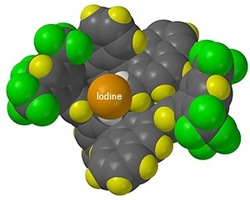Iodine compounds that contain extra electrons can replace hazardous metal catalysts for the synthesis of pharmaceuticals

An iodine salt (pictured) can be transformed into an active hypervalent catalyst through hydrogen peroxide activation.
c 2010 K. Ishihara
Many of the catalysts used in the production of pharmaceuticals contain toxic heavy metals, which have obvious disadvantages in terms of environmental and public health. Now, according to a study by scientists from Nagoya University1, such catalysts could be replaced with 'hypervalent' iodine compounds that hold more than the standard eight electrons in their bonding shells.
Kazuaki Ishihara and colleagues from the Elucidation and Design of Materials and Molecular Functions GCOE program have found that a tiny amount of a specially designed iodine salt with a precisely defined three-dimensional shape, in combination with environmentally benign reagents, can catalyze an important organic ring-closing reaction. The catalyst allows near-complete control over the final product geometry, and represents a critical development in the drive towards sustainable chemical processes.
Metals are widely used in catalysis, despite the associated costs and hazards, because they can undergo reduction/oxidation (redox) reactions that add or remove electrons from the target molecules. Scientists have begun to develop carbon-based 'organocatalysts', but so far these have poor redox capabilities. One alternative is to use iodine atoms, which can readily undergo redox reactions by accommodating excess electrons in their valence levels.
"Iodine is one of the most abundant elements and its toxicity is relatively low, making it very attractive as a 'green' redox organocatalyst," says Ishihara.
Unfortunately, hypervalent iodine must be handled carefully, as it is so sensitive that shocks could potentially make it explode. To get around this problem, chemists have devised methods involving the transformation of aromatic ring-stabilized 'precatalysts' into active hypervalent catalysts during preparation. However, these activations require harsh processing conditions and produce flammable organic byproducts.
Ishihara and his colleagues developed a much milder activation approach by mixing an iodine salt precatalyst with hydrogen peroxide, a common bleach. This reaction produced hypervalent hypoiodite or iodite catalysts and generated only water as a byproduct. By activating the peroxide in a solution of ketophenol compounds, the researchers produced large quantities of dihydrobenzofuran -- a double-ringed molecule used in the synthesis of many bioactive compounds.
As a final hurdle, however, this reaction produces two mirror-image versions of dihydrobenzofuran, known as enantiomers. To ensure that only one of the enantiomers is produced, the researchers swapped the original achiral ammonium salt in the mixture with a chiral version that has a precisely defined three-dimensional shape. This led to the highest enantiomeric selectivity ever reported for hypervalent iodine catalysts.
Making the switch from metals to green iodine catalysts could impact the production of compounds ranging from insecticides to leukemia drugs by reducing waste and improving efficiency. This would not only benefit the environment, but also save money for manufacturers.
Affiliated Researchers
The Nagoya University affiliated researchers mentioned in this highlight are from the Elucidation and Design of Materials and Molecular Functions GCOE program of the Graduate School of Engineering.
Reference
- Uyanik, M., Okamoto, H., Yasui, T. & Ishihara, K. Quaternary ammonium (hypo)iodite catalysis for enantioselective oxidative cycloetherification. Science 328, 1376-1379 (2010). | article